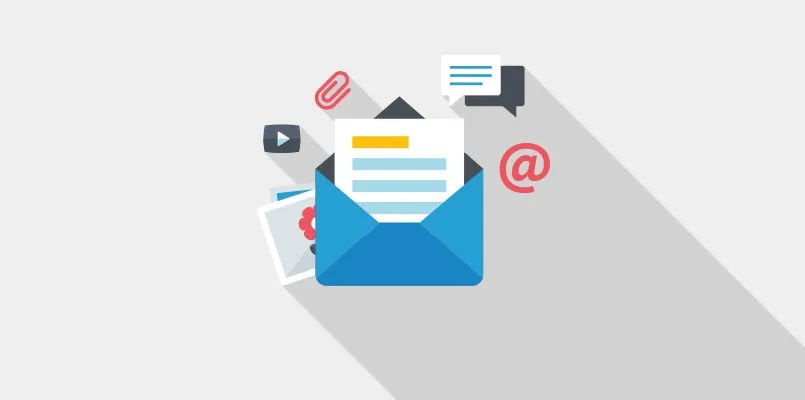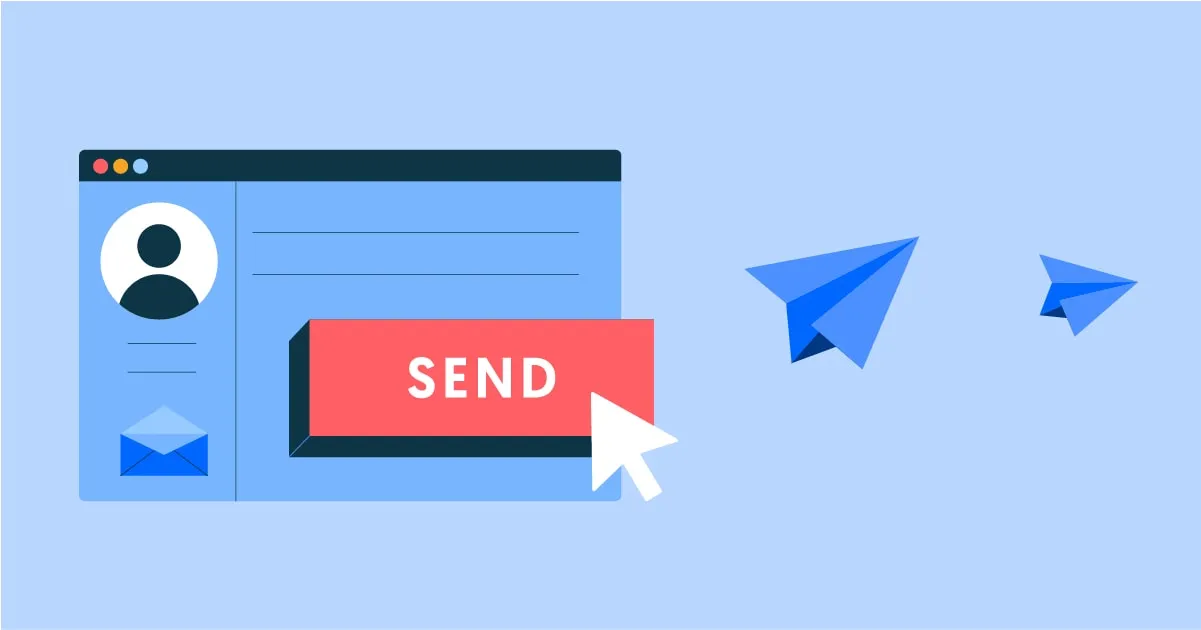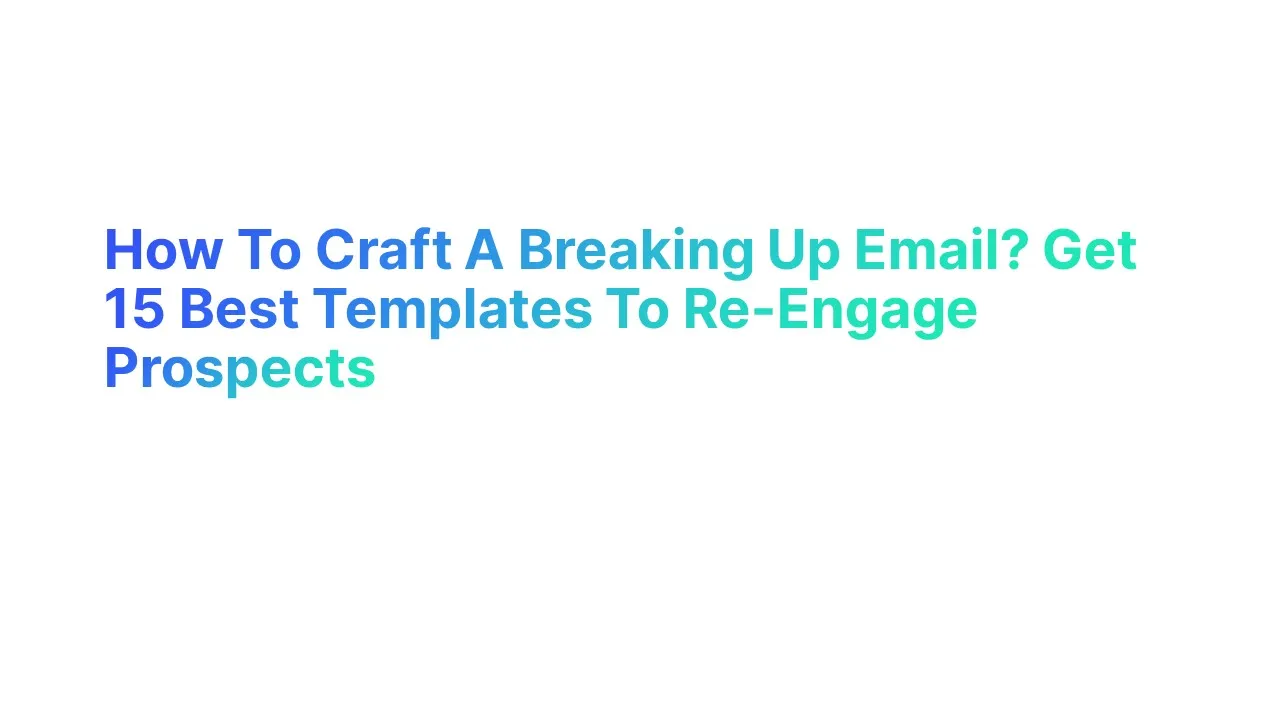What is a Sales Breakup Email?

Breakup emails are an essential part of managing your sales process effectively. A sales breakup email, also known as a follow-up email, is a message sent by a sales rep to a potential customer who has not responded to previous emails or interactions as part of your sales outreach.
A sales breakup email is a crucial part of sales outreach. It is a polite way to end the communication loop while leaving the door open for future engagement. Addressing specific pain points in your breakup email can highlight how your product or service can help.
Achieving the president’s club status can be more attainable with a well-managed sales pipeline.
Why Use a Sales Breakup Email?
Break up emails are crucial for wrapping up unresponsive leads in a professional manner. Below are the reasons as to why you should use break up email:
- Close the Loop on Cold Prospects: Helps to finalize unresponsive leads, ensuring clarity. Closing the loop on unresponsive prospects allows you to focus on closing more deals.
- Improve Sales Engagement: Enhances the overall quality of interactions in your sales process.
- Enhance Your Sales Funnel: Ensures that only the most interested leads remain in your pipeline.
- Effective Time and Resource Management: Incorporating breakup emails helps manage time and resources better.
- Improve Sales Efficiency: Knowing when to send a breakup email can lead to more efficient sales operations.
- Creates a Positive Impression: Leaving a positive impression can also help in maintaining a healthy sales cycle by showing professionalism and respect for the prospect’s decision. Keep your breakup email free from emotional tension; maintain a professional tone.
- Focus on Responsive Leads: Especially useful when the sales pipeline is full, allowing focus on leads more likely to convert.
- Understand Prospect’s Needs and Timing: Crafting a compelling breakup email requires an understanding of these aspects.
- Professional Closure: Crucial for wrapping up unresponsive leads professionally.
- Strategic Final Touchpoint: A well-crafted breakup email can re-engage the prospect or politely conclude the sales process.
- Consistency with Templates: Using a breakup email sales template can streamline efforts and ensure consistency.
44% of salespeople give up after one follow-up, while 80% of sales require at least five follow-ups (source: Invesp).
How To Write An Effective Sales Breakup Emails

Here’s a sales breakup email example to illustrate how you can structure your message.
Incorporating a well-structured email sequence can significantly improve your chances of re-engaging prospects.
1. Create a Compelling Subject Line
The subject line is the first thing your potential customer will see. It needs to grab their attention and make them want to open your email.
Why It Is Important:
A compelling subject line can increase your email open rates and improve your click-through rates.
How to Implement:
- Keep it short and clear.
- Use something that shows urgency or importance, like “Final Attempt to Connect”.
- Personalize it with the prospect’s name or company name, e.g., “Is This the End,
2. Open with Empathy
Start your email by acknowledging the prospect’s potential reasons for not responding. Show understanding and empathy for their situation. Addressing a specific pain point in your breakup email can catch the prospect’s attention.
Why It Is Important:
Opening with empathy shows that you respect the prospect’s time and situation. Opening with empathy can strengthen your customer relationship by showing that you respect the prospect’s time and situation. This can create a positive impression and increase the chances of a response.
How to Implement:
- Begin with a friendly greeting: “Hi [Prospect Name], I hope this email finds you well.”
- Acknowledge their situation: “I understand you may be busy or have different priorities right now.” “Even if it’s not the right time now, remember, this is not only my pup.”
- Express your willingness to help them moving forward if their situation changes.
- If the prospect is moving in a different direction, a breakup email can acknowledge this while leaving the door open.
- Keep the tone polite and professional.
Example: “Hi [Prospect Name], I hope this email finds you well. I’ve tried to reach out a few times regarding [Product/Service], but I haven’t heard back from you. I understand you may be busy or have different priorities right now.”
3. Address the Silence
Explain why you are sending the breakup email and address the lack of response directly. Acknowledge the prospect's silence in a respectful manner.
Why It Is Important:
Addressing the silence directly can clarify your intentions and make the purpose of your sales outreach clear. It also gives the prospect a chance to reconsider their lack of response. Ensure you have a concise email body to maintain the prospect’s interest.
How to Implement:
- Be direct but polite: “I noticed we haven’t been able to connect recently.” Let the prospect know that you will stop bothering them if they are not interested.
- Offer value: “If you’re still interested in [Product/Service], I’d be happy to provide more information or answer any questions.” Over the past couple of weeks, I have tried to reach you several times.
- Provide a clear call to action: “Please let me know if you’re still interested or if now is not the right time.” Highlight a few key areas where your product can provide value.
- Offer the prospect an easy way to let you know if they want you to stop contacting them.
Example: “I noticed we haven’t been able to connect recently. If you’re still interested in [Product/Service], I’d be happy to provide more information or answer any questions. Please let me know if you’re still interested or if now is not the right time.”
4. Offer a Positive Impression
Convey a positive tone even if the prospect has not responded. This ensures that your last impression is a good one.
Why It Is Important:
Leaving a positive impression can keep the door open for future engagement. It shows professionalism and respect for the prospect’s decision. Leaving a positive impression can also help in maintaining a healthy sales cycle by showing professionalism and respect for the prospect’s decision.
How to Implement:
- Use positive language: “I understand that this may not be the right time for you.” Using tentative tones can make your breakup email less confrontational.
- Avoid using a guilt trip in your email; keep the tone positive and professional.
- Show appreciation: “Thank you for considering [Product/Service].”
- Including the sales rep name in the email can add a personal touch.
- Keep it friendly: “I hope we can connect again in the future.”
Example: “Thank you for considering [Product/Service]. I understand that this may not be the right time for you. I hope we can connect again in the future.” Include this email in your overall email sequence strategy. Mentioning success with other clients can build credibility.
5. Provide Value Before Signing Off
Before you end the email, offer something valuable, such as a helpful resource or a summary of your value proposition.
Why It Is Important:
Providing value can give the prospect a reason to reconsider and respond. Providing value can be a key part of your sales strategy, giving the prospect a reason to reconsider and respond. It shows potential customers that you are still interested in helping them.
How to Implement:
- Include a resource: “Here’s a link to our latest guide on [topic].” Providing additional resources can add value to your breakup email.
- Summarize benefits: “Remember, [Product/Service] can help you achieve [specific benefit].”
- If needed, re explain the benefits of your product in the breakup email.
- Keep it brief and relevant.
Example: “Here’s a link to our latest guide on [topic]. Remember, [Product/Service] can help you achieve [specific benefit].”
6. End with a Polite Closing
End your sales email here with a polite and professional closing. Thank the prospect and provide a way for them to get back to you if they wish.
Why It Is Important:
A polite closing leaves a good last impression and encourages the prospect to respond if they reconsider.
How to Implement:
- Thank the prospect: "Thank you for your time and consideration."
- Provide contact info: "Feel free to reach out if you have any questions."
- Sign off politely: "Best regards, [Your Name]."
- Let the prospect know they can personally reach you if they have any questions.
Example: "Thank you for your time and consideration. Feel free to reach out if you have any questions. Best regards, [Your Name]."
15 Breakup Email Template

Below are many breakup email templates that can be tailored to different scenarios. These templates can also be used effectively in cold emailing strategies.
Using these templates can save time and improve the effectiveness of your email sequence.
1. Direct Approach
The Direct Approach is a straightforward email that clearly states the purpose of the email body before ending the communication.
Why It’s Important:
Being direct can save time for both you and the prospect. It shows respect for their decision and clears your sales pipeline for more responsive leads.
Example Template:
This template can be used when you want to be clear and concise. It respects the prospect's time and decision.
2. Positive Impression
The Positive Impression email focuses on leaving a good impression, regardless of the prospect’s response.
Why It’s Important:
Leaving a positive impression ensures that the door is open for future engagement. It shows professionalism and respect for the prospect’s time.
Example Template:
This email leaves a positive impression and keeps the lines of communication open for future opportunities.
3. Last Attempt
The Last Attempt email is a final effort to get a response from the prospect. It clearly states that this is the last communication unless the prospect replies.
Why It’s Important:
This approach gives the prospect one last chance to respond. It can trigger a response from those who were indecisive or too busy to reply earlier.
Example Template:
This template is useful when you want to make a final push to get a response and close the loop if the prospect is not interested.
4. Helpful Resources
A helpful resources email provides the prospect with useful information or tools, even if they decide not to proceed with your product or service.
Why It’s Important:
Offering helpful resources leaves a positive impression and shows that you value the prospect’s needs. It can also keep the door open for future engagement.
Example Template:
This email provides value by sharing relevant resources, which can help maintain a positive relationship with the prospect.
5. Future Engagement
A future engagement email indicates that you are open to reconnecting with the prospect when they are ready.
Why It’s Important:
This approach keeps the communication loop open and shows that you respect the prospect’s current situation and timing.
Example Template:
This template shows that you are respectful of the prospect’s time and willing to reconnect when it suits them. Following template can ensure you cover all necessary points in your breakup email.
6. Tentative Tone
A tentative tone email is gentle and acknowledges that the prospect may not be interested right now, but it leaves the door open for future communication.
Why It’s Important:
Using a tentative tone can reduce pressure on the prospect and make them more comfortable with the idea of reaching out later.
Example Template:
This email uses a gentle approach, showing that you understand the prospect's situation and are available if their needs change.
7. Cold Outreach Final Note
A cold email outreach final note is an email sent to prospects who haven't responded to previous cold emails. It is a polite way to end the communication while leaving the door open for future contact.
Why It’s Important:
This email helps clear your sales pipeline and focus on more responsive leads. It also maintains professionalism and leaves a positive impression.
Example Template:
This email template helps close the loop respectfully and leaves a positive impression for future engagement.
8. Follow-Up Courtesy
A follow-up courtesy email is a polite message sent after several attempts to contact a prospect. It acknowledges the lack of response and offers a chance to reconnect in the future.
Why It’s Important:
This approach shows respect for the prospect’s time and decision, leaving a door open for future opportunities.
Example Template:
This email shows courtesy and professionalism, making it easier for the prospect's company to reach out when they are ready.
9. Last Ditch Effort
A last-ditch effort email is a final attempt to get a response from a prospect. It clearly states that this is the last communication unless the prospect replies.
Why It’s Important:
This email gives the prospect one last chance to respond and can sometimes trigger a reply from those who were undecided or too busy earlier to hit reply.
Example Template:
This template is useful for making a final push to get a response and to close the loop if the prospect is not interested.
10. Neutral Message
A neutral message is an email that communicates the end of outreach without emotional language. It is straightforward and professional.
Why It’s Important:
A neutral message ensures that the breakup email is clear and respectful. It avoids any negative feelings and maintains professionalism.
Example Template:
This template helps to clearly communicate the end of outreach while maintaining a professional tone.
11. Response Rates Booster
A response rates booster email is designed to encourage a response by including a compelling call to action or an incentive.
Why It’s Important:
This type of email can increase the chances of getting a response from the prospect, which can lead to further engagement or a potential sale.
Example Template:
Offering an incentive can encourage the prospect to respond, increasing sales funnel and the effectiveness of your final outreach.
12. Guilt-Free Goodbye
A guilt-free goodbye email acknowledges the lack of response and politely ends the communication, making it clear that the prospect should not feel bad for not responding.
Why It’s Important:
This approach leaves a positive impression and shows that you respect the prospect’s time and decision.
Example Template:
This email ensures that the prospect feels no guilt for not responding and leaves the door open for future engagement.
13. Emotional Closure
An emotional closure email acknowledges the end of communication while expressing gratitude and understanding.
Why It’s Important:
This type of cold emailing also helps to leave a positive impression and shows empathy, which can be important for maintaining a good relationship for future engagements.
Example Template:
This email template shows gratitude and understanding, leaving the door open for future contact.
14. Final Resource Offer
A final resource offer email provides the prospect with valuable resources or information, even if they decide not to proceed with your product or service.
Why It’s Important:
Offering helpful resources can leave a positive impression and provide value to the prospect, which can encourage them to consider you in the future.
Example Template:
This email offers valuable resources, showing that you care about the prospect’s success.
15. Re-engagement Opportunity
A re-engagement opportunity email invites the prospect to reconnect in the future when they are ready.
Why It’s Important:
This approach keeps the lines of communication open and shows that you respect the prospect’s timing and situation.
Example Template:
This email respects the prospect’s timing and invites them to reconnect when they are ready.
Conclusion
Writing a breaking up email is important for closing the loop with a potential customer who hasn't responded. It helps you keep your sales pipeline clean and professional. Using breakup email subject lines and email templates can make this process easier.
When crafting a sales breakup email, always keep a positive impression. This shows respect and leaves the door open for future engagement. Follow these steps and you'll get a response more often.
Remember, each breakup email should be clear and concise. Use simple language. By doing this, you'll ensure your message is effective and professional.









